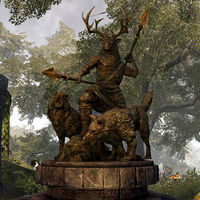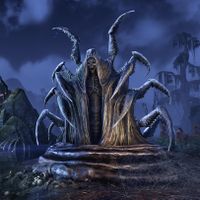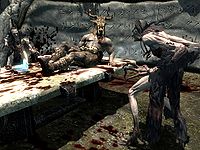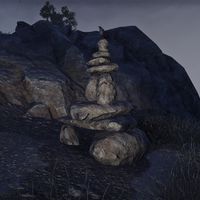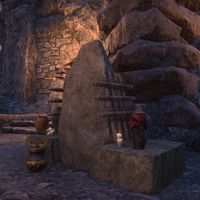Lore:Death/Reachman
Reachfolk Beliefs and Customs[edit]
Reachfolk Afterlife[edit]
Reachmen primarily worship Hircine, the most primal of the Daedric Princes, although some clans are said to also dedicate ceremonies to Molag Bal, Malacath, Mehrunes Dagon, and Namira.[1][2] Their shamans venerate the Hagraven "matrons", who in turn grant them knowledge of nature magic.[3] It is unknown if their souls are claimed by any of those Daedric Princes to their realms.
Reachfolk do not fear death but understand the value of a fleeting life and believe that no matter the struggle, one should not go quietly into death. Lorkh represents a will to live despite of the certainty of death. They believe everyone deserves to be able to die under the open sky, rather than hidden in darkness. There is common belief among the Reachfolk that their ancestors observe them from the sky above and await reunion during which the stories of the battles their descendants fought will be exchanged.[4] They believe that any death has significance, no matter how great or small.[5]
Namira, who is known as the Spirit Queen, the Goddess of Death,[6] and the Black Fly,[7] is a revered spirit in the Reachman pantheon that represents darkness, endings, and rebirth.[8] She is seen as the sovereign of the infinite world of spirit, one of the two worlds of existence.[6] The Reachfolk creation story speaks of Lorkh having an epiphany when he visited the darkness; that which is perceived as nothingness is ripe for possibility.[9] And so, Lorkh approached Namira and convinced her to grant him a place in the infinite void to create a realm for wayward spirits, but it was not without a cost. Lorkh sacrificed himself to create a harsh realm, one that is unforgiving and intended to teach through suffering.[10] Hircine took the mantle of Lorkh's creation, becoming the sovereign the second world: the realm of flesh.[6] The Reachfolk believe that Hircine will fight alongside them at the "end of all days".[5][11] Some recorded poems that touch upon the subject of the undead suggest that individuals resurrected through necromantic means may be denied the opportunity to embrace that afterlife.[12]
Hircine and Namira's roles complement each other. While Reachfolk dwell in the world of the living, Hircine is a guide that helps them navigate Nirn's hardships.[13] Upon death, Namira acts as a psychopomp for Reachman souls that gives and takes lives, until their spirits are enlightened. Thus, Namira is seen as the avatar of primal dualisms, such as beginnings and ends, which stem from her world of spirit.[6] At the "end of all days", Hircine will fight alongside the Reachmen,[5] and Lorkh's Dark Heart will beat again, reawakened by feeding on the deaths of mortals, and its darkness will spread from its depths to consume everything, sparing only Namira's faithful.[14]
Hircine engenders a sense of urgency; the unease needed to keep the people of the Reach safe, as there may be another threat looming over the horizon. Thus, Hircine has reason to be cruel in his lessons. He also taught the Reachfolk how to hunt, fight, and survive,[13] all in an effort to make them swifter, stronger, and more cunning.[15] The briarheart ritual is reflective of this need to improve, and involves communing with Hircine to ritualistically replace the heart of a skilled Reachfolk warrior with poisoned briars.[16] Reachfolk religion puts a huge emphasis on the concepts of the suffering and self-sacrifice and this ritual in particular represents Lorkh's immortal sacrifice,[10] which is reflected by an act of self sacrifice - ending one's own life for the protection of their loved ones, with the end result being that the warrior is resurrected[17] as a living weapon with great strength and endurance at the cost of the feeling of the unending, constant pain.[18] These warriors are called "Briarhearts".[19]
Reachfolk Funerary Customs[edit]
Reachfolk of various clans typically wear amulets, talismans or other trinkets connected to their understanding of the death.[4][20] Wildblood Clan members are responsible for crafting their own talisman which is unique to that person and their family. It represents the relationship between hunter and prey, and is deeply personal to their beliefs about life and death. Those talismans are an important part of guiding their loved one's spirit home and are kept by living relatives of the deceased.[20] Bear-Heart Clan also fashioned similar trinkets.[21] Amulets that belonged to the deceased who were banished from the clan are buried it on the banks of the Karth River in order to bring peace to the spirit of the fallen. The ancient Reachfolk poem, Fynboar the Resurrected, reflects a tradition where a symbolic death token was carved from a tree in honor of a departed loved one. This token served as a reminder of life's uncertainties. Interestingly, Hermaeus Mora, the Daedric Prince of Knowledge, remained unaware of this tradition until Fynboar's son shared it with him, seeking knowledge on how to resurrect his father.[12] Similar beliefs were shared by at least some Reachfolk who are not part of those clans.[4]
It is known that they share the funerary practice of burial with their Nord neighbors, Breton cousins and Nedic forefathers.[22][23][24][25] Warriors of the Spiritblood who felt defending the ways of their ancestors are honored by having Totems of the Brave erected in their honor.[26] They were also granted immortality in form of the vateshran song that was was passed down and sung forever.[27] Vateshran are responsible for ritualistical commemoration of the dead ancestors.[4] Cairns are scattered across the landscape of the Reach and some of them are known to be erected by the Reachfolk in places where blood of their brethren was spilled[28] and are often used as grave markers.[29] Reachfolk of Markarth typically practiced burial, as well.[30] In certain circumstances cremation is also performed.[31][32]
Although the accounts on Reachfolk burial practices are sparse, the burial of the legendary hero of the Reach Faolan is described in detail. Mortally wounded[33] or dead[24], Red Eagle was carried by the weeping cortege up the crag at dawn. Reachfolk followed with pots of resin and ash in order to prepare his body for burial. Ashes were scattered to lay upon his body which was exposed to the chiefs of numerous clans. According to Reachfolk ceremony was interrupted by Hag who took the briarheart from Faolan's chest despite the protests of the attendants. Once she left the ceremony continued and he was carried into the deep cave in the heart of the mountain which was a place of a prepared tomb and then he was "laid bare for the last time in sleepless rest" in the tomb. The stone was sealed, wax poured and flints shattered.[24] After the burial numerous traps were set to dissuade intruders and grave robbers. The resting place appeared unadorned at first but in the deeper parts of the tomb the rippled rock walls were replaced by ornate man made walls of hewn stone and covered with chiseled murals depicting scenes of Red Eagle's final battle. Despite the rich ornamentation of the room and later parts of the corridor that led to it the sarcophagus placed on dais in the central part of the chamber was simple and unadorned. Faolan was buried with his legendary weapon - Red Eagle's Bane, which was put on a pedestal near to his body.[23]
References[edit]
- ^ Aspects of Lord Hircine — Juno Procillus, Academy of Chorrol
- ^ Loading screens in ESO
- ^ The Improved Emperor's Guide to Tamriel: Northern Bangkorai and the Mountains — Flaccus Terentius, 2E 581
- ^ a b c d Ardanir's dialogue in ESO
- ^ a b c High Shaman Glynroch's dialogue in ESO
- ^ a b c d Great Spirits of the Reach: Volume 3 — Vashu gra-Morga, Chief Daedrotheologist at the University of Gwylim
- ^ Reach Witch Chant — Varana Tappo, Imperial Scribe serving the Longhouse Emperors
- ^ Namira's Dance — Gemma Pamphelius, Cultural Scribe
- ^ The Dark Descent's loading screen in ESO
- ^ a b Great Spirits of the Reach: Volume 5 — Vashu gra-Morga, Chief Daedrotheologist at the University of Gwylim
- ^ Letter to Apprentice Gwerina — High Shaman Glynroch
- ^ a b Fynboar the Resurrected
- ^ a b Ardanir's dialogue in ESO
- ^ Arana's dialogue during The Awakening Darkness in ESO: Markarth
- ^ Great Spirits of the Reach: Volume 2 — Vashu gra-Morga, Chief Daedrotheologist at the University of Gwylim
- ^ The Improved Emperor's Guide to Tamriel: Northern Bangkorai and the Mountains — Flaccus Terentius, 2E 581
- ^ Faorin's dialogue in ESO
- ^ Kyrtos' dialogue in ESO
- ^ Medone's dialogue in ESO
- ^ a b Bralthahawn's dialogue in ESO
- ^ Bear-Heart Clan Necklace quest item description in ESO
- ^ Rebel's Cairn quest in Skyrim
- ^ a b The Red Curse — Dettethor Pantenne
- ^ a b c The Translated Works of Tosmorn, IV — Xandier Edette
Edited by Vanesse Aurilie - ^ The Translated Works of Tosmorn, III — Xandier Edette
Edited by Vanesse Aurilie - ^ Lamenter of the Slain's dialogue in ESO
- ^ Rites Matron's dialogue in ESO
- ^ Eslyn's dialogue in ESO
- ^ The Translated Works of Tosmorn, II — Xandier Edette
Edited by Vanesse Aurilie - ^ Ard Caddach's dialogue in ESO
- ^ Bonfire Wicker-Steed description in ESO
- ^ Scary Tales of the Deep Folk, Book 3 — Cassia Volcatia, Traveling Scribe
- ^ The Legend of Red Eagle — Tredayn Dren
